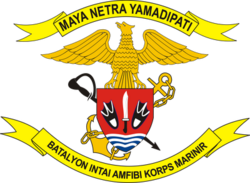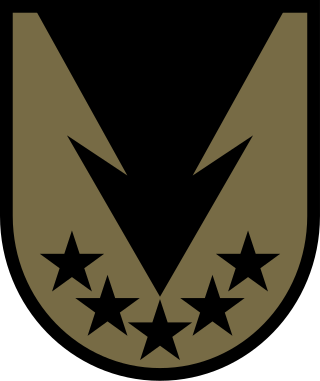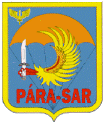
A paratrooper or military parachutist is a soldier trained to conduct military operations by parachuting directly into an area of operations, usually as part of a large airborne forces unit. Traditionally paratroopers fight only as light infantry armed with small arms and light weapons, although some paratroopers can also function as artillerymen or mechanized infantry by utilizing field guns, infantry fighting vehicles and light tanks that are often used in surprise attacks to seize strategic positions behind enemy lines such as airfields, bridges and major roads.

High-altitude military parachuting, or military free fall (MFF), is a method of delivering military personnel, military equipment, and other military supplies from a transport aircraft at a high altitude via free-fall parachute insertion. Two techniques are used: HALO and HAHO.

Force Reconnaissance (FORECON) are United States Marine Corps deep reconnaissance companies that supply military intelligence to the command element of the Marine Air-Ground Task Force (MAGTF). Force Reconnaissance companies, unlike USMC division reconnaissance, report to the Marine expeditionary force (MEF) and provide direct action and deep reconnaissance during large-scale operations.

A long-range reconnaissance patrol, or LRRP, is a small, well-armed reconnaissance team that patrols deep in enemy-held territory.

In military organizations, a pathfinder is a specialized soldier inserted or dropped into place in order to set up and operate drop zones, pickup zones, and helicopter landing sites for airborne operations, air resupply operations, or other air operations in support of the ground unit commander. Pathfinders first appeared in World War II, and continue to serve an important role in today's modern armed forces, providing commanders with the option of flexibly employing air assets. There was a group of pilots who were also designated pathfinders. They flew C-47 (DC-3) aircraft and were the lead planes followed by paratroop transports, used for dropping paratroopers into designate drop zones such as on D-Day, the Normandy Invasion.

A parachutist badge is a badge awarded by armed forces or paramilitary forces of many states to personnel who have received parachute training and completed the required number of jumps. It is difficult to assess which country was the first to introduce such an award.

The Parachutist Badge, also commonly referred to as "Jump Wings", is a military badge of the United States Armed Forces. Some services, such as the Marine Corps, officially refer to it as an insignia instead of a badge. The United States Space Force and United States Coast Guard are the only branches that do not award the Parachutist Badge, but their members are authorized to receive the Parachutist Badges of other services in accordance with their prescribed requirements. The DoD military services are all awarded the same Military Parachutist Badge. The U.S. Army and U.S. Air Force issue the same Senior and Master Parachutist Badges while the U.S. Navy and U.S. Marine Corps issue the Navy and Marine Corps Parachutist Insignia to advanced parachutists. The majority of the services earn their Military Parachutist Badge through the U.S. Army Airborne School.

The 509th Infantry Regiment is an airborne infantry regiment of the United States Army. The unit was initially activated as a single battalion, the 504th Parachute Infantry Battalion, in October 1941 at Fort Benning, Georgia. Nicknamed "Geronimo", the 509th conducted the U.S. Army's first combat jump during World War II on 8 November 1942, flying 1,500 miles from England to seize Tafarquay airport in Oran, Algeria. The 509th made a total of five combat jumps during the war.

Taifib is an elite recon unit within the Indonesian Marine Corps which is tasked for conducting amphibious reconnaissance and special reconnaissance. It is operationally similar to the Combat Reconnaissance Platoon from the Army's Kostrad corps. Taifib was previously known as Kipam which literally means in English: the Para-Amphibious reconnaissance Commandos, it was formed in 1961.
The Divers Group is the Portuguese Navy's sapper clearance diver unit. It was created in 2004 through the grouping of the several already existing diving subunits, to exercise administrative, logistical and operational control and management, maritime special operations capable, over all diver units and personnel. It groups under a single command, all previously existing Sappers Divers Units and Services.
The 323rd Parachute Ranger Squadron or Fallskärmsjägarna is a Swedish military special operations capable airborne ranger unit specialising in long-range reconnaissance.
The United States Army long range surveillance detachment (LRSD) is organized as a detachment organic to the military intelligence battalion at division level for the purpose of long-range surveillance. The LRSD's are organized into a headquarters section, communications section (two base radio stations), and six surveillance teams. (Light division LRS detachments only have four surveillance teams.) The leaders are airborne and Ranger qualified. All other personnel in the detachment are airborne qualified. Most active Army LRSDs were inactivated in September 2005, with the notable exceptions 173rd Airborne's LRSD which was deactivated in 2006 and the 82nd Airborne's LRSD, which was converted to Pathfinders in 2008, and most Army National Guard units were inactivated in September 2008; some were transferred to battlefield surveillance brigades and were reflagged and redesignated as Troop C within the brigade's cavalry squadron (reconnaissance and surveillance). For example, the 151st Infantry Detachment (LRS) of the 38th Infantry Division became Troop C (LRS), 2d Squadron, 152d Cavalry Regiment, 219th Battlefield Surveillance Brigade. Two new National Guard Long Range Surveillance Companies were stood up in September 2009.

Special reconnaissance (SR) is conducted by small units, such as a recon team, made up of highly trained military personnel, usually from special forces units and/or military intelligence organizations. Special reconnaissance teams operate behind enemy lines, avoiding direct combat and detection by the enemy. As a role, SR is distinct from commando operations, but both are often carried out by the same units. The SR role frequently includes covert direction of airstrikes and indirect fire, in areas deep behind enemy lines, placement of remotely monitored sensors, and preparations for other special forces. Like other special forces, SR units may also carry out direct action and unconventional warfare, including guerrilla operations.

The Commando Parachute Group is a unit of elite pathfinders within the French Army's 11th Parachute Brigade. These pathfinders are paratroopers drawn from the various regiments of the brigade who then undertake GCP training and must pass various requirements. Referred to as "commandos paras", they numbered less than 250 men in 2015 out of the more than 8,000 paratroopers serving in the 11e BP. This unit doesn’t belong to French Special Forces but to 11 Parachute Brigade.
The Marine Corps Test Unit 1, or MCTU #1, was an experimental testing unit of the United States Marine Corps. It was established outside the Fleet Marine Force for the development of specialized tactics, techniques and organizational concepts, and to evaluate its tangible employment in the nuclear age. It reported directly to the Commandant of the Marine Corps.

The Esquadrão Aeroterrestre de Salvamento (EAS), known by its nickname Para-SAR, is a Brazilian Air Force special operations search and rescue squadron, based in the city of Campo Grande.

The 68th Special Forces Brigade was the old name of the unconventional warfare branch of the Bulgarian Armed Forces. It is an independent branch under the direct command of the Chief of Defence since February 1, 2017. Before that, the brigade was within the force structure of the Land Forces. It was one of two Bulgarian military special operations units, the second one being the Naval Special Reconnaissance Detachment, a combat frogmen unit, retained within the structure of the Bulgarian Navy. The 68th SF Brigade was transformed into the Joint Special Operations Command on November 1, 2019.

The Pathfinder Company (Parachute) (Malay: Kompeni Pandura (Para), pronounced ) is a pathfinder and reconnaissance unit within Malaysian Army's 10th Parachute Brigade (10 PARA BDE).

















